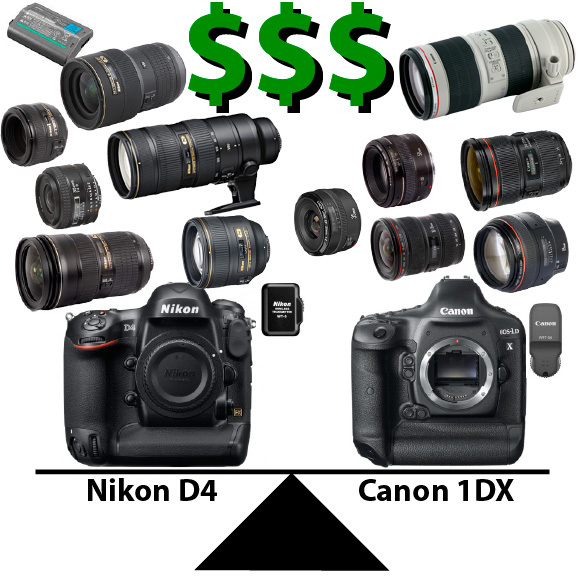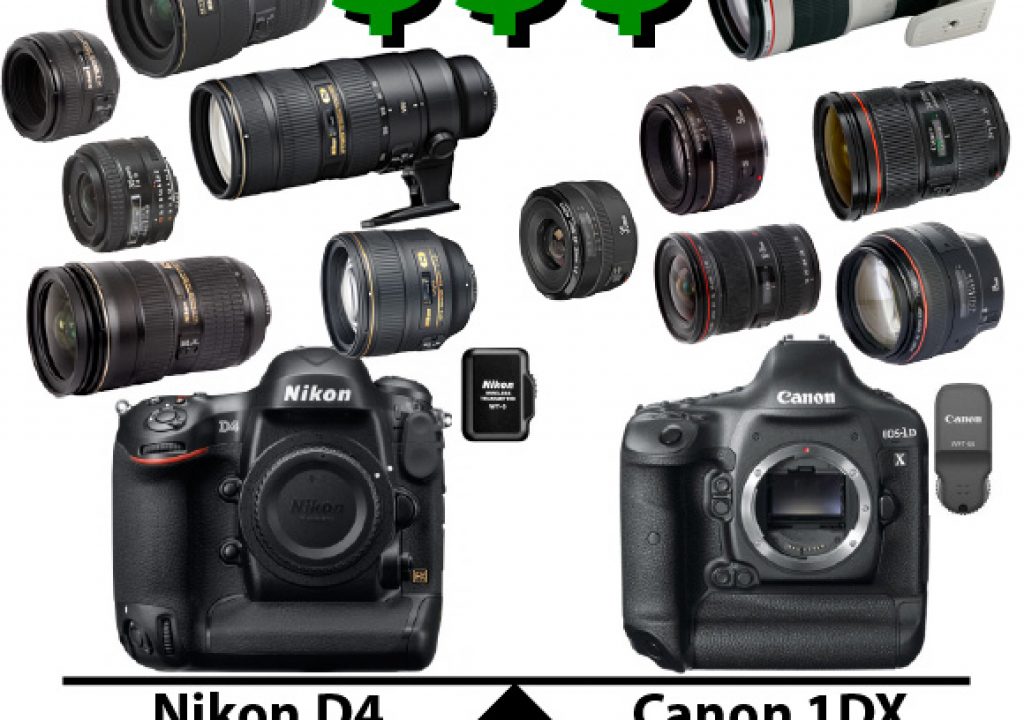
OK, so I wrote up this article comparing prices of kitting out a Nikon D800 vs a Canon 5D Mark III, and decided I wanted to keep going, so here’s the same thing for the Nikon D4 vs the Canon 1DX.
To the point version:
How much does it cost to kit out these cameras similarly? All prices from B&H since that’s where I get my kit, they get it soon and their prices are competitive. I round off to the nearest few bucks because hey, life is short.
Starting with a basic setup – the body, 2 extra batteries and a 24-70 zoom:
Starter Kits
Nikon Pro Starter Kit:
Nikon D4: $6000
2x Nikon EN-EL18 battery: $340
Nikon 24-70mm f/2.8G ED: $1900
Canon Pro Starter Kit:
Canon 1DX: $6800
2x Canon LP-E4: $234
Canon EF 24-70 f/2.8L II (the new one): $2300
TOTALS:
Nikon: $8240
Canon: $9334
Difference: $1094, Canon is 13% more expensive.
Conclusion: no great surprise since the Canon body is more $800 expensive, and the similar zoom is $400 more expensive – but also brand new, so hopefully quite a bit nicer. The sneaky part is that Nikon’s batteries are MUCH more expensive. Want an extra charger? The Nikon is $350 (D3S charger was about $200), the Canon LC-E4N Battery Charger? No price known yet.
Pro Kits
OK, but who wants to live with only one lens? The classic f2.8 pro lens line-up for Nikon is the 14-24, 24-70, and 70-200. But the 14-24 is big, heavy, expensive, and most importantly, unprotectable – the bulbous front element won’t take a filter. So for my own kit I opted for the lighter, slower, sharper, less costly 16-35 f4, and conveniently Canon has a similar 16-35 f2, so to keep this apples to apples we’ll use that. You could definitely make a case for wanting the Canon 8-15mm f4 instead for $1500, but you’d have a gap in your focal length range.
Nikon Pro Kit:
Nikon D4: $6000
2x Nikon EN-EL18 battery: $340
AF-S Nikkor 16-35mm f/4G ED VR: $1140
Nikon 24-70mm f/2.8G ED: $1900
AF-S Nikkor 70-200mm f/2.8G ED VR II: $2400
Canon Pro Kit:
Canon 1DX: $6800
2x Canon LP-E4: $234
Canon EF 16-35mm f/2.8L II USM: $1700
Canon EF 24-70 f/2.8L II (the new one): $2300
Canon EF 70-200mm f/2.8L IS II USM: $2300
TOTALS:
Nikon: $11,780
Canon: $13,334
Difference: $1554, Canon is 13% more expensive.
Conclusion: Same percentage difference, Canon still a bit more expensive. In this case, however, the pricier Canon 16-35 wide angle has a definitive advantage over the Nikon – it is a stop faster at f2.8 instead of f4.0. Also, it is their L series, which is their pro lineup, the Nikon is really prosumer grade with a plastic body. Tack sharp, but LOTS of distortion on the Nikon.
The Nikon long zoom is a bit more than the Canon.
Pimped Out (how I’m doing it)
What’s that? Keep going? OK. I’ll follow along with the choices I’ve already made – over the years I’ve added some decent not awesome primes -a 35mm f2 and a 50mm f1.4, as well as a 2x teleconverter. I plan on getting a nice pro 85mm f1.4 but haven’t yet. While we’re at it, lets throw in the wireless module for both cameras. The pricier Nikon allows for remote viewing and operation of the camera, I haven’t heard that the 1DX can do that, so I’m thinking no. (confirmed later). Is this ideal, or totally recommended? NO. For full on pro usage, I’d upgrade the 35 & 50mm lenses to the pro f1.2/f1.4 versions for each. This is just an apples to apples based on what I’ve got, not what I’d ideally build from scratch. Oh, and lets also throw in the GPS unit for each.
Nikon Pimped Kit:
Nikon D4: $6000
2x Nikon EN-EL18 battery: $340
AF-S Nikkor 16-35mm f/4G ED VR: $1140
Nikon 24-70mm f/2.8G ED: $1900
AF-S Nikkor 70-200mm f/2.8G ED VR II: $2400
Nikon AF Nikkor 35mm f/2.0D: $365
Nikon AF-S Nikkor 50mm f/1.4G: $440
Nikon AF-S NIKKOR 85mm f/1.4G: $1700
Nikon TC-20E III 2x Teleconverter: $490
Nikon WT-5A: $880
Nikon GP-1: $195
Canon Pimped Kit:
Canon 1DX: $6800
2x Canon LP-E4: $234
Canon EF 16-35mm f/2.8L II USM: $1700
Canon EF 24-70 f/2.8L II (the new one): $2300
Canon EF 70-200mm f/2.8L IS II USM: $2300
Canon EF 35mm f/2.0: $330
Canon Normal EF 50mm f/1.4 USM: $380
Canon EF 85mm f/1.2L II USM: $2200
Canon 2x EF Extender III: $474
Canon WFT-E6A: $500
Canon GP-E2: $270
TOTALS:
Nikon: $15,850
Canon: $17,488
Difference: $1638, Canon is 10% more expensive
Conclusion: the gap has narrowed at this point. The Canon 85mm is 1/3 stop faster at f1.2 not f1.4, and the wireless setups aren’t the same in functionality, part of the $500 Nikon price whammy. The non-pro primes are give-and-take on which costs more, but the awesome Canon 85mm f1.2 is a chunky $500 more. Also, the GPS unit (a few years newer than Nikon’s) is clearly nicer – both units will geotag where/when the pictures were taken, but the Canon can additionally tell you what direction you were pointing. Both units can be attached to the flash hot shoe to mount them on the camera, but the Canon also uses that for its data connection. The Nikon has to have a big ungainly, breaks easily (I’m on my third $45 cable after a couple of years) cable from the GPS unit to the front of the camera’s 10 pin connector. So while it costs more, there’s clearly a quality/get what you paid for argument to be made based on the specs.
Want to know more about how these lenses compare? See page 2 of this article I wrote.
Pimped Out (how I should’ve done it)
OK, my inner OCD/Asperger’s Kid can’t let this one go – this is the same as above, but what I would’ve done if I’d started from scratch, rather than what I did do building from a DX setup.
Nikon Pimped Kit:
Nikon D4: $6000
2x Nikon EN-EL18 battery: $340
AF-S Nikkor 16-35mm f/4G ED VR: $1140
Nikon 24-70mm f/2.8G ED: $1900
AF-S Nikkor 70-200mm f/2.8G ED VR II: $2400
NikonAF-S NIKKOR 35mm f/1.4G: $1600
Nikon NIKKOR 50mm f/1.2 AIS + AF-S Nikkor 50mm f/1.4G: $700+440=$1140
Nikon AF-S NIKKOR 85mm f/1.4G: $1700
Nikon TC-20E III 2x Teleconverter: $490
Nikon WT-5A: $880
Nikon GP-1: $195
Canon Pimped Kit:
Canon 1DX: $6800
2x Canon LP-E4: $234
Canon EF 16-35mm f/2.8L II USM: $1700
Canon EF 24-70 f/2.8L II (the new one): $2300
Canon EF 70-200mm f/2.8L IS II USM: $2300
Canon EF 35mm f/1.4L USM: $$1,380.00
Canon Normal EF 50mm f/1.2L USM: $1500
Canon EF 85mm f/1.2L II USM: $2200
Canon 2x EF Extender III: $474
Canon WFT-E6A: $500
Canon GP-E2: $270
TOTALS:
Nikon: $17,785
Canon: $19,658
Difference: $1873, Canon is 11% more expensive
More Notable Differences: while the 35mm lenses are a fair match here, the 50mm are NOT. Canon offers an excellent L series 50mm f1.2, and Nikon doesn’t have a similar lens. The Canon is sharper according to dxomark.com, but not by a huge amount. The L series build quality is better than the Nikon options, and the price reflects it. Instead, I chose here two Nikon 50mm lenses – the older f1.2 (to match the stop) but is manual focus, and the newer 50mm f1.4G which is auto focus. Together they still cost less than the Canon, so that was about as balanced as I could get it, lumpy as it is.
Conclusion: the price gap widens a bit, with the additional caveats directly above in addition to the caveats of the last section. Overall, Canon seems to be a bit pricier, but for this selection of focal lengths, tends to have lower minimum f-stops (bigger maximum apertures) and more pro built lenses – again, for these particular focal lengths that I’ve chosen.
Conclusions
OK, so what have we learned? Canon kit costs a touch more for this PARTICULAR setup – but only 10-13% more. I’d say if you had a predilection for Canon, 10-13% shouldn’t make a big difference to sway you. And by the time you add in cases and carrying bags and tripods and heads and filters and cleaning gear and and and other stuff that costs the exact same amount either way…the price difference will become even less as you dilute the differences by addding commonalities. Yeah, you could buy an extra pro lens with the difference, but overall I’d say you’d be happier saving or spending the money getting the system you’re more comfortable with. And that will go to the nitty gritty features of the two cameras, which are pretty darned close overall, much closer than the D800 and 5D Mark III, since the 1DX and D4 are aimed at precisely the same market. So close in fact, I don’t even feel the urge to write it up. Which feels better in your hand? What do you want to do with it? And if you’re shooting video, is it for you or for rental? I’m betting the renting public will be much more comfortable renting a 1DX than a D4, regardless of their relative merits, only going on the overwhelming mindshare of Canon for video applications.
Meh.
Too rich for your blood? A fun idea but too expensive? Then you might want to take a look at a similar write-up comparing costs of the Nikon D800 and Canon 5D Mark III.
-mike
Disclaimer: I own 4 Nikon bodies and a bunch of lenses (as described above) and several Canon Powershots, but have no working relationship with either company. I buy my gear from B&H because I like’em and their prices are good and I’ve had good luck with them, but I get no Product Luv or discounts from them for mentioning them here – that’s the extent of my relationship with them. I’ve also rounded off pricing to the nearest convenient-to-me unit, so if you’re adding it up and it doesn’t match, don’t freak out – I was just trying to keep the math easier.

